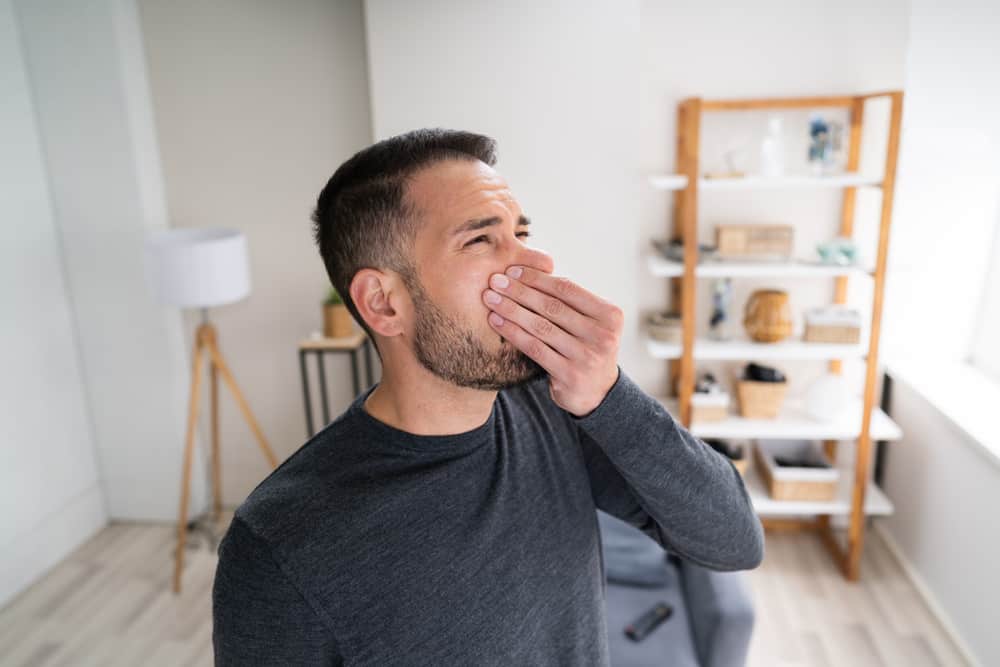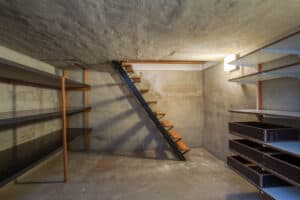
As a homeowner, you need to learn to be very observant when it comes to sounds.
The more sounds you can pick up on, the more you can do to keep track of all that is going on around your home.
If you are hearing lots of noises, it could mean there are issues or even some critters that are working their way around your home.
If this is the case, these issues need to be tended to immediately.
Let’s look at some of the reasons you might be hearing a dripping sound in your ceiling and the things that you can do about it.
Dripping Sound in Ceiling, No Water (5 Possible Reasons)

1. Pipe Expansion
One of the main reasons you may hear a dripping sound in your ceiling is that a pipe is expanding or contracting.
When you hear this noise, you are going to have a hard time telling if it is dripping water or if the pipe is expanding.
The two noises are almost exactly the same.
If you are downstairs and can hear it through the ceiling, you would have to go upstairs to investigate this.
Pipes will expand and contract when they are exposed to different temperatures.
If the pipes are water pipes, then you will notice that, when the hot water is running, you may hear this noise.
This is because the hot water makes the pipes expand.
The weather outside can also make this happen to the pipes.
It can be hard to tell when the pipes are expanding and contracting, and you will often need to think about the changes or events that are occurring in your home.
Sometimes being a homeowner also requires you to be a bit of a detective.
Making sure you know what is going on at any given time in the home can help you in your investigation of the issues that are going on.
2. Water in Pipes
Although you have already investigated the fact that there is no water in your ceiling, you may still have water in your pipes.
The water inside your pipes can drip even after the water has stopped flowing through the pipes, and this may end up causing you to hear a dripping noise.
Water in your pipes is typically not a problem.
However, it could indicate that you have some clogs in your pipes.
Since the water is still lingering and dripping after the fact, chances are there could be hair or other types of buildup in the pipes, slowing the flow of water.
Water should flow through pipes with ease, and although you can sometimes hear this noise, it is not necessarily loud or a dripping noise.
The dripping noise is distinct, and as always, you will need to make sure that it is not caused by a water leak in your ceiling.
3. Condensation Drip Pan
When an air conditioner is running, it creates quite a bit of condensation.
This condensation goes into a pipe which then transfers the water from the condensation outside.
When this happens, the water will flow through the home and outdoors so that it can keep the area where the condenser is dry.
There is a condensation drip pan that is located next to the place where the water needs to flow out.
This drip pan should be dry at all times, and it will be as long as your drip pan is functioning correctly.
However, there are times when the drip pan could fill up.
This is a sign that there is a problem with the AC unit, and it needs to be checked on immediately.
Sometimes if there is water dripping into the drip pan, you will be able to hear it, and you will have to do something about it before it turns into a leak in your home.
This can seem as though it is not an immediate issue, but it will likely turn into one rather quickly.
4. Fluorescent Lighting
Fluorescent lighting is very popular in some attics.
These lights tend to last a long time, and they were a good way to add a high power and bright light to the attic when they were installed.
Most people don’t have outlets and lamps in their attic, and fluorescent lighting takes the place of this.
The problem with these fluorescent lightbulbs is that they tend to flicker.
The bulbs can be very finicky when it comes to the temperature and the conditions in the house at the time you turn the bulb on.
The fluorescent lighting tends to make a ticking noise when it doesn’t turn on fully.
This noise usually means that your fluorescent lightbulb is ready to be changed.
The changing of these bulbs is not complicated, and it should stop the noise that you are hearing.
Although this noise may be a little different from the exact sound of dripping water, it can be very close.
If you hear this noise, you should take a look at the lightbulbs in your attic and see if they are starting to lose their strength or if they have any discoloration.
Chances are, if they take a long time to turn on or the clicking or dripping noise gets worse, the bulb is about to lose all of its power and will soon fail to work.
When you replace your fluorescent lighting in the attic, see if you can do it with an LED bulb.
The LED lights tend to offer people much better longevity from the bulb, and they usually do not make any noises at all.
5. Improper Support for Piping
Sometimes piping in the attic is not properly supported.
Piping should have the correct brackets and supports in place in order to function properly to bring water in and out of the house.
If the piping does not have the proper support, then it can make some strange noises.
You will also notice that, when pipes are not properly supported, the water does not flow the way that it should.
This, in turn, can lead to water pooling up in pipes and getting caught in certain areas.
The pooling and catching of water will eventually create problems, and it could cause pipes to break or smell, or buildup could accumulate as well.
It is essential that pipes in your attic are supported properly.
When water flows through these pipes, they will sometimes expand and then touch the studs or rafters in your home.
If that happens, it can cause the dripping noise to get louder and more apparent.
Overall, the improper support for piping can cause an increase in the noises that you hear in your attic.
Have a plumber come over and take a look at these pipes to see if additional support can be added.
If you don’t want to hire a plumber, you can always check the area out on your own and see if you can figure out what is causing the problem.
Signs of a Water Leak

The most important thing to remember when you are looking for a potential water leak issue is that there are sometimes multiple signs.
Everyone thinks that they will hear water running or dripping, but in reality, you may not.
Sometimes the water falls very quietly, and therefore, you won’t hear it at all as it falls and starts to cause damage to your home.
There are five signs that indicate a water leak which you should look for and start checking to find out what is causing these issues.
1. Peeling Paint

If you see that there is paint peeling from your walls, it could be a sign of water damage.
Most of the time, the paint will only peel from the wall if there are water or moisture issues.
Now, if you have not painted your home in the last thirty years, other things could be causing this paint issue to develop.
Keep this in mind before you panic about the fact that your paint is peeling.
2. Cracks on the Wall

In addition to peeling paint, you must keep an eye out for cracks on the wall.
Sometimes the cracks on the wall are going to be very visible, but sometimes, the cracks will be seen in the wallpaper.
The wallpaper could be peeling as well.
If the cracks are already visible on the wall, chances are the leak has been around for quite some time.
3. Cracked Floors

In addition to cracks on the walls, it is good to look at the condition of the floors.
People tend to look down much more often than they look up.
This means that a spot on the floor may direct your head back up to a spot on the ceiling where water may be coming through.
The water on the floor means it is an excellent time to start working on a fix for this issue or leak.
4. Moldy or Musty Smell

Another telltale sign that you have a real leak is that there will be a moldy or musty smell coming from the attic.
You will probably find that this smell is located only in one room of the house, and it is difficult to get rid of the smell.
Even when you use proper ventilation, you will likely notice that the smell lingers and will not leave.
This usually means that the musty smell is growing in the attic and that it needs to be stopped before the leak gets worse.
5. Mold or Mildew

Last but certainly not least, see if you start to notice mold or mildew in certain areas of your home.
This could be a sign that there is extra moisture from a leak in a wall or the ceiling.
In order to fix this, you are going to need to stop the presence of water that is causing it.
Mold and mildew grow when there is moisture around to feed its growth.
Don’t assume that the dripping noise you are hearing is a leak.
There are typically other signs that you will hear or see along with it.
In addition, you should always be looking at the condition of your walls and ceiling to make sure there are no additional issues.
Being a great homeowner also means being diligent about taking care of your home.
Conclusion
Hopefully, you now have enough information to start checking on the source of this dripping noise and coming up with a solution.
The most important thing is to try and investigate it enough that you eliminate the fact that there could be damage being caused by the noise.
Letting something like this linger could mean that the fix is going to be more costly and time-consuming to take care of.
Instead, know the reasons behind the dripping noise and get started on the investigation process as soon as possible.



Leave a Reply